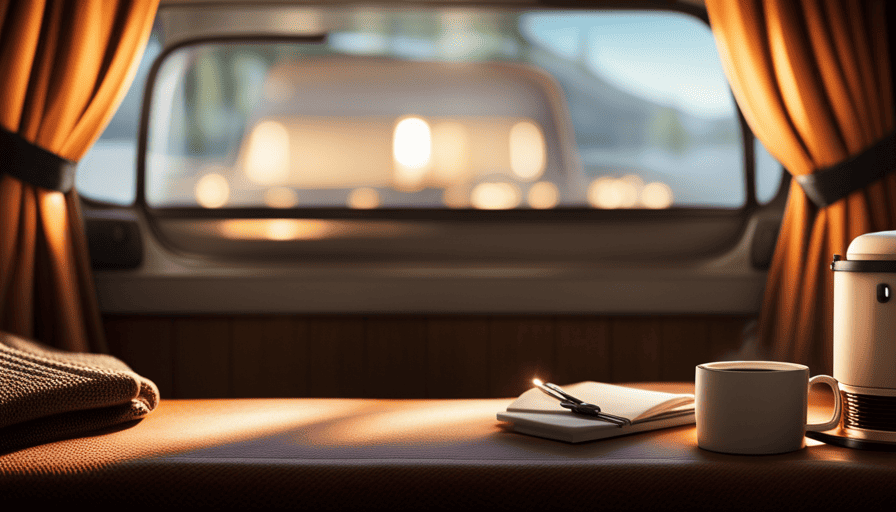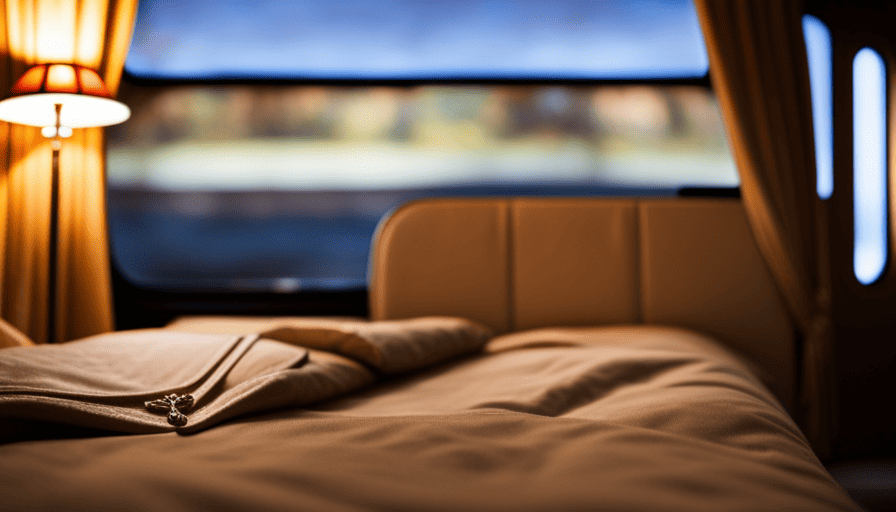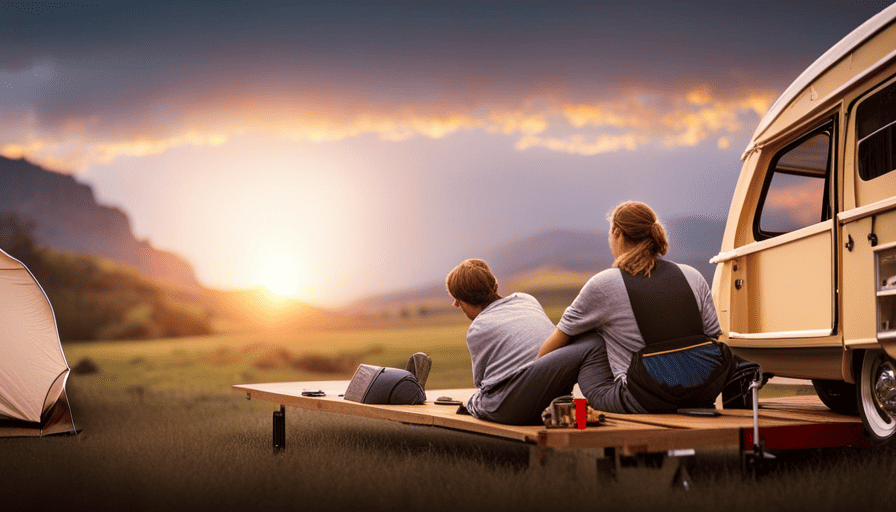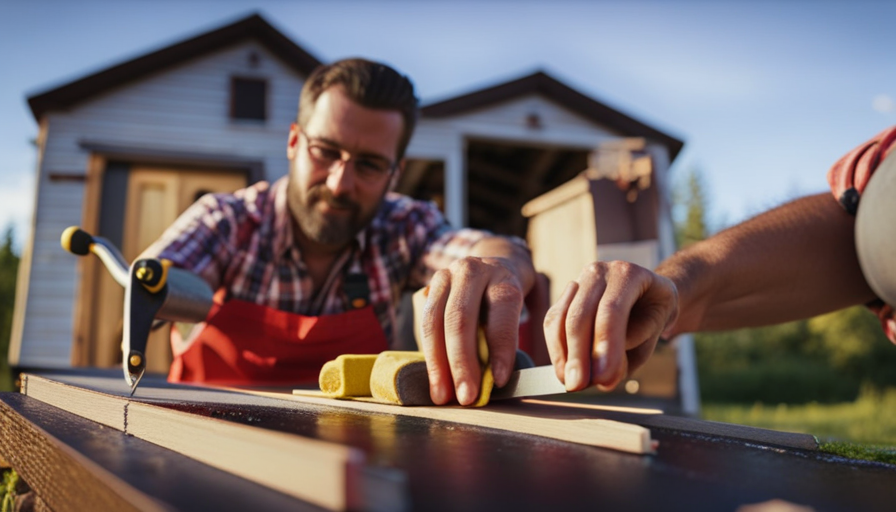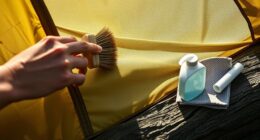The saying ‘where there’s a will, there’s a way’ is perfectly applicable to heating a camper. By using a touch of creativity and the appropriate gear, maintaining a warm and pleasant atmosphere in your camper during the chilliest weather is entirely possible.
In this article, I will guide you through the process of heating your camper using electricity, providing you with practical tips and techniques to ensure your camping adventures are warm and enjoyable. First and foremost, it’s important to ensure that your camper has a reliable source of electricity. In order to heat your camper using electricity, you will need to have access to a power source, such as a campground electrical hookup or a reliable camper battery hook up. Once you have established a power source, you can utilize electric heaters or portable electric blankets to keep your camper warm and cozy during your outdoor excursions.
First, we’ll explore the various power source options available to you, from shore power to generators.
Then, we’ll delve into the world of electric heaters, discussing their different types and how to choose the right one for your camper.
Additionally, I’ll share tips on insulating your camper effectively to maximize heat retention.
We’ll also discuss the benefits of electric blankets, heated mattress pads, and even electric radiant floor heating.
Throughout this journey, I’ll emphasize the importance of monitoring your electricity usage and following safety precautions.
So, let’s dive in and discover the secrets of heating your camper with electricity!
Key Takeaways
- Investing in an electric heater with safety features like tip-over protection and overheating protection is recommended.
- Insulating the camper is crucial for maximizing heat retention.
- Portable electric space heaters are convenient and versatile for heating specific areas in the camper.
- Monitoring electricity usage and following safety precautions are important throughout the heating process.
Assess Your Power Source Options
You’ll need to assess your power source options to determine how you can efficiently heat your camper using electricity. Evaluating power efficiency is crucial to ensure that you choose the most effective option for heating your camper. Comparing different power sources will help you make an informed decision.
When it comes to heating your camper with electricity, there are a few power source options to consider. One option is to rely on your RV’s built-in electrical system. This system typically runs on a combination of battery power and shore power when you’re connected to an external power source. Assess the power capacity of your RV’s electrical system and evaluate its efficiency in providing heat for your camper.
Another power source option is a portable generator. These generators can be used to power electric heaters and other appliances in your camper. However, it’s important to compare the fuel efficiency and power output of different generators to ensure they can meet your heating needs.
Investing in an electric heater is the next step in efficiently heating your camper. By using electricity as the power source, electric heaters can provide consistent and reliable heat. Transitioning into the subsequent section, investing in an electric heater will ensure that you have a reliable and efficient way to keep your camper warm during cold weather.
Invest in an Electric Heater
Investing in an electric heater can be a practical solution for keeping your camper warm. When considering electric heaters, it’s important to prioritize safety. Look for heaters that have built-in safety features such as tip-over protection and overheating protection. These features can help prevent accidents and ensure the well-being of both you and your camper.
Additionally, choose energy-efficient electric heaters to minimize your electricity usage and save on costs. Energy-efficient electric heaters are designed to provide maximum warmth while using minimal energy. Look for heaters with adjustable thermostats and programmable timers, as these features allow you to regulate the temperature and save energy when you’re not in the camper.
It’s also worth considering portable electric heaters, as they can be easily moved around to different areas of the camper based on your heating needs.
Before purchasing an electric heater, make sure to check the power requirements of your camper. Ensure that your power source can handle the electrical load of the heater to prevent any electrical issues or hazards.
As you invest in an electric heater, don’t forget to insulate your camper. Proper insulation can significantly improve the efficiency and effectiveness of your heating system.
Insulate Your Camper
Make your camper cozy and warm by insulating it properly, ensuring that you stay snug and comfortable during your camping adventures. To achieve maximum efficiency in heating your camper with electricity, it’s essential to invest in energy-efficient insulation options. Here are two sub-lists that’ll help you make the right choices:
-
Energy-efficient insulation options:
- Spray foam insulation: This method provides excellent coverage and seals any gaps or cracks in your camper’s walls, floor, and ceiling, minimizing heat loss and improving energy efficiency.
- Reflective insulation: This type of insulation is made of a reflective material that reflects heat back into the camper, reducing heat loss and keeping the interior warm.
-
Weatherproofing techniques for campers:
- Seal windows and doors: Use weatherstripping or caulk to seal any gaps around windows and doors, preventing cold drafts from entering your camper.
- Insulate the floor: Use foam board insulation or thermal mats to insulate the floor and prevent heat loss through the ground.
By implementing these energy-efficient insulation options and weatherproofing techniques, you can effectively retain heat inside your camper and minimize energy consumption.
In the next section, we’ll discuss how to further enhance your warmth and comfort by using electric blankets or heated mattress pads.
Use Electric Blankets or Heated Mattress Pads
Stay warm and cozy in your camper by snuggling up with the comforting warmth of an electric blanket or heated mattress pad. This ensures that you’re as snug as a bug in a rug during your camping adventures. Electric blankets are a popular choice for campers looking to stay warm without using excessive electricity. However, it’s important to follow electric blanket safety guidelines to prevent any accidents.
Make sure to inspect the blanket for any damages before use, and never fold or bunch it up when in use. It’s also recommended to use a timer or auto-shutoff feature to prevent overheating or fire hazards.
On the other hand, heated mattress pads offer a more consistent and evenly distributed warmth throughout the night. They’re designed to be placed directly on top of your mattress and provide a gentle heat that helps you sleep comfortably. One of the major benefits of heated mattress pads is that they can help alleviate body aches and pains, making your camping experience even more enjoyable. Additionally, they’re energy efficient and can save you money by reducing the need for additional heating sources.
As you explore different ways to heat your camper with electricity, consider the option of installing electric radiant floor heating. This innovative solution provides warmth from the ground up, creating a cozy environment inside your camper.
Install Electric Radiant Floor Heating
To truly transform your camping experience, picture yourself stepping onto a floor that radiates warmth, creating an inviting and cozy atmosphere inside your camper. Installing electric radiant floor heating in your camper can provide you with the comfort and luxury you desire.
Here’s a breakdown of the electric radiant floor installation process and the benefits of this heating method:
- First, make sure your camper’s floor is clean and dry.
- Lay down a layer of insulation to prevent heat loss.
- Install the electric heating mats or cables evenly across the floor, following the manufacturer’s instructions.
- Connect the mats or cables to a thermostat for temperature control.
- Cover the heating system with a layer of thinset or self-leveling compound.
- Finally, install the flooring material of your choice over the top.
The benefits of electric radiant floor heating are numerous. Firstly, it provides an even distribution of heat throughout your camper, eliminating cold spots. Secondly, it operates silently, creating a peaceful environment. Additionally, electric radiant floor heating is energy-efficient, allowing you to save on electricity costs. Lastly, it’s a low-maintenance option, requiring minimal upkeep.
Transitioning to the next section about using portable electric space heaters, these devices offer a convenient and versatile way to heat your camper.
Utilize Portable Electric Space Heaters
To efficiently heat specific areas in my camper, I utilize portable electric space heaters. These heaters allow me to target the areas that need the most warmth and conserve energy. However, it’s crucial to follow safety guidelines to prevent accidents and ensure proper ventilation. For example, keep the heater away from flammable materials and don’t leave it unattended.
Use portable electric space heaters to heat specific areas in your camper
Maximize your camper’s coziness by using portable electric space heaters to target specific areas for a toasty retreat. When it comes to heating your camper, portable electric heaters are a great option due to their convenience and energy efficiency.
Here are three ways you can use these heaters to heat specific areas in your camper:
-
Zone Heating: Place a portable electric space heater in the area where you spend the most time, such as the living area or bedroom, to provide targeted warmth.
-
Under-Desk Heating: If you have a workspace in your camper, place a compact electric heater under your desk to keep your feet and lower body warm while you work.
-
Bathroom Heating: Use a portable electric heater in the bathroom to create a cozy environment while you shower or get ready for the day.
By utilizing portable electric space heaters in these areas, you can create a comfortable and warm living space in your camper. However, it’s important to follow safety guidelines to prevent accidents and ensure proper ventilation.
[Transition sentence]: To ensure a safe and warm camper, it’s essential to follow safety guidelines and ensure proper ventilation.Follow safety guidelines to prevent accidents and ensure proper ventilation
Make sure you prioritize safety and proper ventilation to prevent accidents and ensure a cozy and secure environment in your camper. Proper ventilation is essential when using electric space heaters to heat your camper. It helps to maintain a healthy air quality, prevent the buildup of carbon monoxide, and reduce the risk of fire hazards.
Make sure to keep the heater at a safe distance from flammable materials, such as curtains or bedding, and never leave it unattended. Additionally, ensure that the heater is placed on a stable surface to avoid tipping over. It’s also important to regularly clean and inspect the heater for any signs of damage or malfunction.
By following these safety guidelines, you can enjoy a warm and comfortable camper without compromising your well-being.
Now, let’s consider electric fireplace inserts for a more permanent heating solution.
Consider Electric Fireplace Inserts
Imagine cozying up in your camper with an electric fireplace insert, creating a warm and inviting atmosphere that’ll make you never want to leave. Electric fireplace inserts offer numerous benefits and are a great way to heat your camper efficiently and safely. Here are three reasons why electric fireplace inserts are a popular choice among campers:
-
Energy-efficient: Electric fireplace inserts are highly energy-efficient, allowing you to reduce your energy consumption and save on heating costs. They use a heating element and a fan to distribute warm air, providing consistent heat throughout your camper.
-
Easy installation: Installing an electric fireplace insert in your camper is a breeze. Most inserts come with a simple plug-and-play design, so you can easily set it up without the need for professional assistance. This makes it a convenient option for campers who want a hassle-free heating solution.
-
Versatility: Electric fireplace inserts come in various designs and sizes, allowing you to choose the one that best fits your camper’s aesthetic and heating needs. Whether you prefer a traditional or modern look, there are plenty of options available to complement your camper’s interior.
When considering how to heat your camper with electricity, electric fireplace inserts are an excellent choice due to their energy efficiency, ease of installation, and versatility. Another option to explore is the use of electric heated blankets or throws to further enhance your camper’s coziness and warmth.
Use Electric Heated Blankets or Throws
Snuggle up in your camper with the cozy embrace of an electric heated blanket or throw, creating a comforting oasis that will make you never want to leave. Electric heated blankets and throws are a fantastic way to keep warm in your camper without relying on traditional heating methods. They are designed to provide a gentle and consistent heat, ensuring maximum comfort during those chilly nights.
To help you understand the benefits of using electric heated blankets or throws, let’s take a look at the following table:
| Benefits of Electric Heated Blankets or Throws |
|---|
| Provides instant warmth |
| Adjustable temperature settings |
| Energy-efficient |
| Safe to use |
| Easy to clean and maintain |
Electric heated blankets and throws come with a range of features, such as adjustable temperature settings, ensuring you can find the perfect level of warmth for your needs. They are also energy-efficient, meaning you can stay cozy without worrying about excessive electricity usage.
Monitoring your electricity usage is crucial when using electric heated blankets or throws. It allows you to keep track of your energy consumption and make any necessary adjustments to optimize efficiency. Transitioning into the next section, monitoring your electricity usage is an essential step in ensuring your camper stays warm and cozy while minimizing energy wastage.
Monitor Your Electricity Usage
To ensure that I don’t overload my camper’s electrical system, I make it a point to keep track of my electricity consumption. This allows me to stay within the limits of my camper’s electrical capabilities and avoid any potential issues.
Additionally, I find it helpful to invest in a portable power monitor, which enables me to monitor my electricity usage in real-time. This way, I can easily identify any spikes or excessive consumption and make adjustments accordingly to ensure optimal efficiency.
Keep track of your electricity consumption to avoid overloading your camper’s electrical system
Make sure you keep a close eye on your electricity usage to prevent overwhelming your camper’s electrical system. Monitoring your electricity consumption is crucial in preventing electrical overloads and potential damage to your camper’s electrical system.
To effectively manage your electricity usage, consider the following:
-
Install a power monitor: A power monitor allows you to track your electricity consumption in real-time, giving you a clear understanding of your energy usage patterns.
-
Set a daily usage limit: Determine a daily electricity usage limit that suits your camper’s electrical capacity. This will help you stay within safe limits and avoid overloads.
-
Unplug unnecessary devices: When not in use, unplug any unnecessary devices to minimize electricity consumption and reduce the risk of overloading your camper’s electrical system.
By monitoring your electricity usage and implementing these measures, you can prevent overloads and protect your camper’s electrical system. Consider investing in a portable power monitor to monitor your usage in real-time.
Consider investing in a portable power monitor to monitor your usage in real-time
Investing in a portable power monitor allows you to track your energy consumption in real-time, providing you with valuable insights into your usage patterns. A portable power monitor is a device that connects to your camper’s electrical system and displays information about your electricity usage. It helps you keep track of the amount of power you are using, allowing you to make adjustments and conserve energy when needed.
Here is a table that showcases the benefits of using a portable power monitor:
| Benefits of Using a Portable Power Monitor |
|---|
| Real-time energy consumption tracking |
| Identifying energy-hungry appliances |
| Monitoring battery levels and charging |
To ensure efficient electricity usage, consider the following tips:
- Turn off appliances when not in use.
- Use energy-efficient appliances.
- Optimize your heating settings.
- Insulate your camper to retain heat.
By following these tips and monitoring your electricity usage with a portable power monitor, you can effectively manage your energy consumption. Now, let’s discuss the importance of following safety precautions.
Follow Safety Precautions
First and foremost, ensure your safety by taking necessary precautions when using electricity to heat your camper. Imagine this: just like putting on a seatbelt before driving, following these precautions is like creating a protective shield around you and your camper, allowing you to enjoy a cozy and worry-free camping experience.
When it comes to electricity safety, it’s crucial to be aware of potential electrical hazards. Make sure to inspect the electrical system in your camper regularly, looking for any signs of wear or damage. Replace any frayed wires or damaged outlets immediately to prevent the risk of electrical shock or fire.
Another important safety precaution is to never overload your electrical system. Each electrical appliance has its own power requirements, so be mindful of the total power consumption of all the devices you’re using. Overloading the system can lead to overheating and potential electrical malfunctions.
Furthermore, always use grounded electrical outlets and extension cords. Grounding provides an extra layer of protection against electrical shocks by redirecting the electrical current into the ground. Avoid using damaged or frayed extension cords, as they can pose a serious safety hazard.
Lastly, never leave electrical heating devices unattended. Always turn off and unplug any heaters when you leave your camper or go to sleep. This simple step can prevent potential accidents and ensure your safety.
By following these electricity safety precautions, you can enjoy a warm and cozy camping experience without worrying about any electrical hazards. Stay safe and happy camping!
Frequently Asked Questions
Can I use solar power to heat my camper?
Yes, solar power can be used to heat a camper, but its efficiency for heating purposes may vary.
Solar panels can generate electricity, which can then be used to power electric heaters or heat pumps. However, it’s important to note that electric heating can consume a significant amount of energy and drain the battery.
Therefore, it’s advisable to explore alternative heating methods, such as propane or diesel heaters, for more efficient and reliable heating in a camper.
Are there any safety concerns when using electric heaters in a camper?
When using electric heaters in a camper, it’s crucial to prioritize safety. To ensure your well-being, follow these safety tips:
- Never leave the heater unattended.
- Keep it away from flammable materials.
- Use a heater with a tip-over switch.
Additionally, opt for energy-efficient models to minimize power consumption. By adhering to these precautions and choosing efficient heaters, you can stay warm while camping without compromising safety.
How much electricity does an electric heater typically consume?
The electric heater efficiency and the cost of running an electric heater depend on several factors such as the wattage of the heater and the insulation of the space being heated. Typically, electric heaters consume a significant amount of electricity, ranging from 750 to 1500 watts per hour.
This high energy consumption can result in higher electricity bills. Therefore, it’s essential to consider the efficiency and cost implications when using an electric heater.
Can I use an electric heater while my camper is in motion?
Using an electric heater while your camper is in motion is not recommended. It could be dangerous due to the risk of tipping over or causing a fire. Instead, focus on electric heater efficiency when stationary. Consider alternative heating options such as propane heaters or diesel-powered heaters that are specifically designed for use in moving vehicles. These options are safer and more reliable for heating your camper while on the road.
Are there any specific maintenance requirements for electric heating systems in campers?
When it comes to electric heating systems in campers, proper maintenance is crucial. Regularly inspecting and cleaning the heating elements, filters, and vents is essential to ensure optimal performance.
Additionally, troubleshooting electric heating systems may involve checking for loose connections, testing the thermostat, and verifying the power supply.
Following these maintenance requirements and addressing any issues promptly will help keep your electric heating system in good working order and provide efficient heating during your camping trips.
Conclusion
In conclusion, heating a camper with electricity can be an efficient and reliable option for staying warm during your outdoor adventures. By assessing your power source options and investing in electric heaters, blankets, or even radiant floor heating, you can create a cozy and comfortable environment inside your camper.
Just like a warm cup of cocoa on a chilly winter night, these electric heating solutions can keep you snug as a bug in a rug, providing the perfect balance of warmth and convenience.
So go ahead, embrace the power of electricity and enjoy your camping experience to the fullest.

